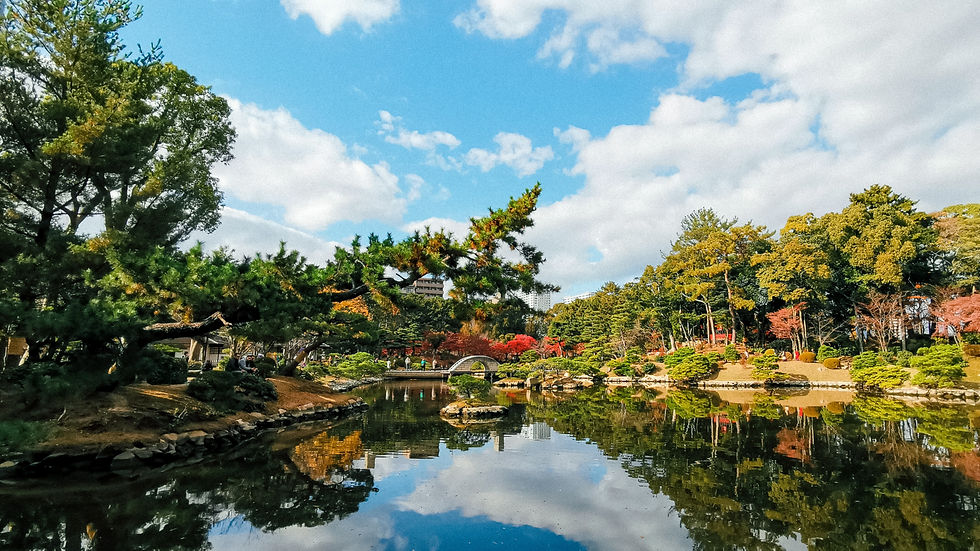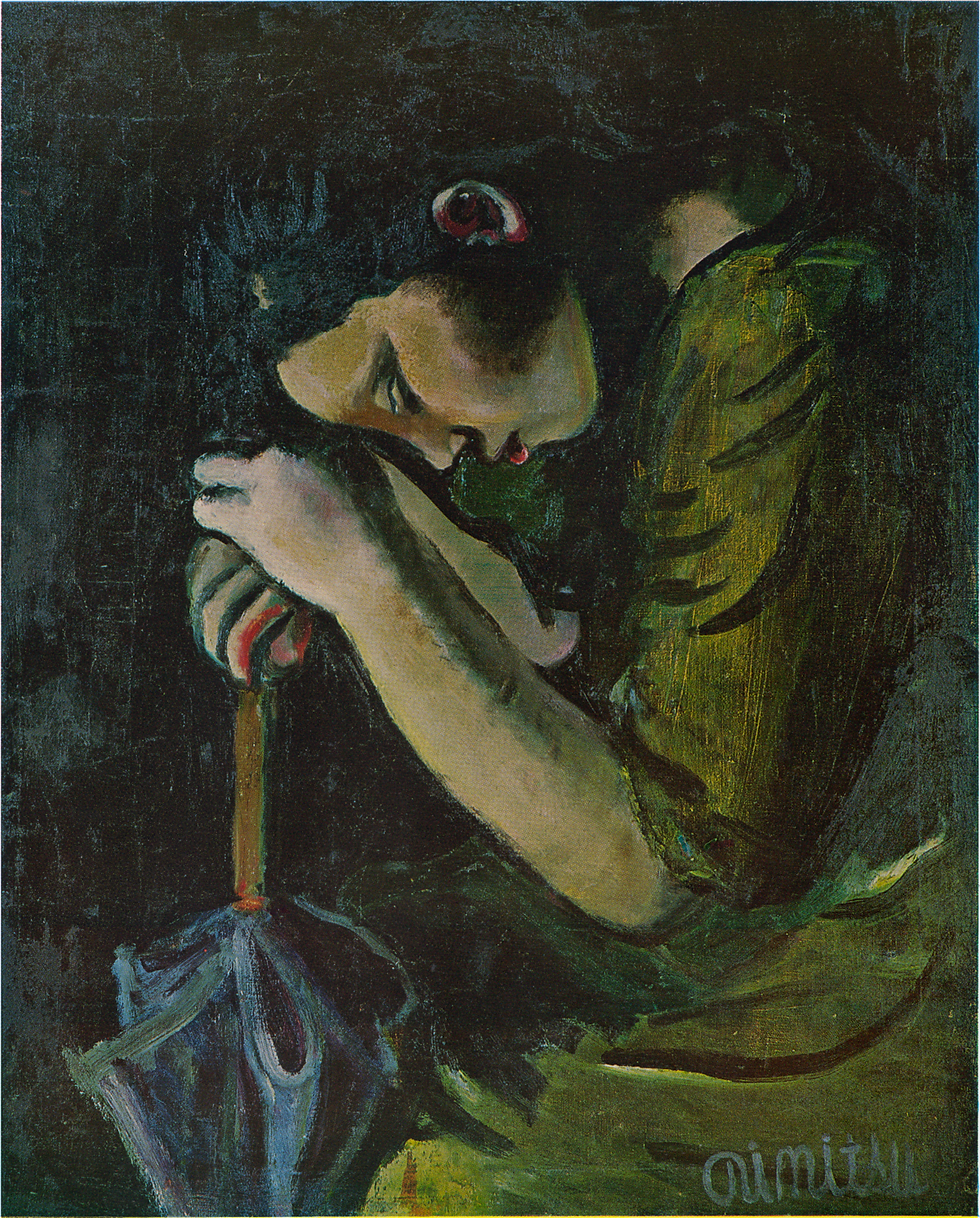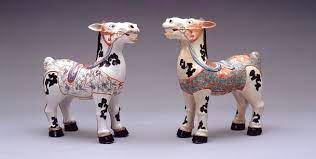Moment of joy: Landscape paintings of familiar places in different times and different styles; artists who were born and raised in Hiroshima and went on to make their marks in Japanese and global fine arts. It was a moment of joy and pride for me.. I realized that Hiroshima, as my second home, already has a very special spot in my heart.

My wife and I went to the Hiroshima Prefectural Art Museum and Shukkei-en garden last Sunday (March 7, 2021), and sure enough, it was a Sunday well spent.
If Hiroshima were a person, here at the museum garden, you can catch her in her most contemplative mood - beautiful, vulnerable, willing to open up in a deep conversation. This is the place where you can get to know the essence of Hiroshima.
On the second-floor gallery rests Salvador Dali’s Dream of Venus, a big window to the wild realm of dreams. In the other exhibition hall are exquisite artworks displaying splendid traditional Japanese craftsmanship. Among them are two porcelain horses, made in the famous Arita village of porcelain craftsmen—which recently, after centuries, found their way home from France. [In this hall?], There are also artworks by artists who have personal bonds with Hiroshima. For me, I have found a few landscape oil paintings depicting the view of places around Hiroshima.
While the special exhibition halls on the 3rd floor and Kenmin gallery on the B1 floor are always bustling with various exhibitions, the 400 hundred years old Shukkei-en gardena remains as tranquil as ever. When its doors swing close behind you, they shut out the rapid pace of this modern world—and any sense of the passage of time.
The museum has a rich collection of 5,000 artworks, which they display on a seasonal rotation, and the Shukkei-en garden is distinctly beautiful in each season, so visiting once is far from enough. You’d want to go there several times a year, just so you wouldn’t miss out.

The Garden
Blossoming in the center of modern-day Hiroshima, this beautiful 400 hundred years old garden is a perfect example of a Japanese gardening tradition that can be traced back to the Middle Ages. This type of gardens, known as a “circular-tour garden,” first appeared in the Muromachi Era (1336-1568), and found its classical form by the 17th century. Around this time, most feudal lords adopted this style for their personal gardens.
Its name, Shukkeien, roughly translates to “shrunken scenery garden,” Shukkeien garden is said to be modeled, in miniature, after the landscapes of Lake Xihu in Hangzhou, China. Indeed, it’s not a very expansive garden. In forty minutes, you can stroll through at a leisurely pace, and still enjoy everything you ought to see. But like many other Japanese crafts, its small size only adds to its beauty
One of the top attractions in Hiroshima, the garden now hosts about 250,000 visitors each year. But no matter how many other visitors are there in the garden, the garden never loses its secluded, tranquil, and harmonious feel.

The Museum
When you walk into the museum, the first thing you notice is the spaciousness of the white atrium and the beautiful view of Shukkei-en garden through its glass wall. On the first floor, you’ll find the library, museum shop & cafe, information gallery, and an Italian restaurant.
On the 2nd floor, you’ll find the collection exhibition, in which the museum displays selected works from its collection of around 5000 artworks. The Collection Exhibition changes 4 times a year. The special exhibitions are held on the 3rd floor. These are some of the most prestigious exhibitions in the prefecture. There are about six special exhibitions a year, so you might want to check out the museum’s event calendar. This time, for example, I was lucky enough to catch The 67th Japan Traditional Kōgei Art & Crafts Exhibition.
The Art
The museum proudly presents the work of Hiroshima-born modern Japanese masters, such as Ikuo Hirayama, Ai-mitsu, Hideki Okuda, and Kobayashi Tokusaburo. Among them are some very personal, touching portraits, landscapes paintings of places as close as Hiroshima station and Hiroshima University, to places so far both in time and distance, such as an ordinary backyard in London, or a caravan traveling on the ancient Silk Road.
Other main themes of the collection exhibition are Nihonga, a traditional form of Japanese painting, and Japanese craft arts. The great eye for beauty in little things, the graceful appreciation of nature, and the meticulous attention to detail—those aspects we all admire in the Japanese—are all fully present in those works.
On the subject of the giants of world art history, it seemed to me that the Prefectural Art Museum focuses on the 20th-century, while The Hiroshima City Museum of Art has an outstanding collection of impressionist and post-impressionist painters. You can find some Salvador Dali, Rene Magritte, Paul Klee, and Marx Ernst there.
Some Notable Artworks
I find that I usually appreciate art even more in its historical context. So here’s a glimpse of the wonderful art you can find there—and please note that what follows is a mere reflection of my personal taste. Also note that you might not be able to see some of them, as the collection exhibition presents only a part of the museum’s collection at a time, changing four times a year.
Salvador Dali. Dream of Venus, 1939.
As you enter the collection exhibition floor, this huge 240x480 oil on canvas painting by Salvador Dali awaits you. Its size, Dali’s realistic depiction of surreal objects, and some other factors I can’t quite explain make for an enigmatic force drawing the viewer into the work. I felt as if I could walk right into this wild imagination; I felt the presence of the painting all around me, not only on the canvas.
Dali learned a lot from old masters such as Caravaggio, Vermeer, and Velazquez, and their influence can be seen in his realistic depiction of surreal objects, and also in his rather stark contrast of light and shadow. The seemingly harsh landscape, the burning giraffes, the swarm of ants, and the melting clocks, the lobsters—these are all recurrent motifs in his world. So in this sense, this is a “classic Dali” painting.

The painting was a part of the exhibition pavilion Dali presented at The New York World Fair in 1939. The pavilion was an early example of installation art, a very ambitious, unconventional, sensational approach to surrealism, and one of the most representative of Dail’s work. In one of the chambers of the pavilion, this painting was exhibited among a few sculptures, and with a female model lying on the bed in front of them.
“The atomic explosion of August 6, 1945, shook me seismically,” Dali once recalled in an interview with writer Andre Parinaud. “Thenceforth, the atom was my favorite food for thought. Many of the landscapes painted in this period express the great fear inspired in me by the announcement of that explosion” Dali was among the first, and perhaps the most prominent Western artist to stand up against the horror of nuclear weapons, and perhaps for this reason, you can find a few other of his major works in different museums in Japan.
Aimitsu. Comisa, 1930.

Though many of his works were lost in the atomic bombing, Aimitsu is well known as the painter at the vanguard of Japan’s surrealist movement. But at the same time, he should also be understood as a portrait painter, since portraits of friends is a theme he often revisited.
n this portrait of his younger sister Comisa, he caught her in a very tender, vulnerable moment. he overall warmth of her garment, the strokes of red on her hand and ear, and the softness of her face and left forearm, are heightened by the “flatness” and dark color palette of the rest of the painting, suggesting warm affection towards his little sister.
On the back of the painting, Aimitsu’s wished for the happiness of his little sister, who was soon to be married.
Ikuo Hirayama. The Holocaust at Hiroshima,1979

Ikuo Hirayama is one of the leading artists of Nihonga, a painting style developed around the 1900 that blends together characteristics of several different traditional Japanese painting schools and some influence from Western fine arts. He was also an avid art collector and advocate who contributed tremendously in preservation and study of cultural heritages related to the Silk Road.
The Holocaust at Hiroshima is his only painting that directly deals with the horror of nuclear weapons, which he himself experienced when he was only fifteen. As he once recalled in an interview with NPR:
“I believe that art can overcome hardships. I believe that flowers can blossom from anguish and inhumanity. You can overcome these things and make something beautiful. I started to create my artwork as a requiem for those who lost their lives in the war. The wish for peace is at the core of my work."
The rest of his oeuvre—magical, dreamy, epicyet delicate— focuses mainly on Buddhism, the Silk Road, and peace. His imagination and knowledge stretch far and wide across time and distance, and remind me of Jorge Luis Borges’s stories.
Figure of Horses in Kakiemon Style, Overglaze Enamels, Late 17th century

Kakiemon is a style of Japanese porcelain developed around the mid-17th century in the town of Arita, in today’s Saga prefecture. Kakiemon was also called Imari porcelain, named after the port they were shipped from. The Dutch East India Company exported a lot of these porcelain products, which had a great influence on European porcelain crafts. Among them were these two porcelain horse figures, and after nearly four centuries, they were proudly brought back home from France. Only five of these horses are known to be preserved until today.
Food, Drinks and More
Though you can hurry through everything you have to see in the Hiroshima Prefectural Art Museum and Shukkeien Garden, even a full day won’t be enough for some to enjoy this beautiful place to the fullest. So if you’re to there for that long, how about lunch and refreshments? Fortunately, you have good options.
Zona Italia in Centro is a high-end Italian restaurant on the first floor. The service is on point, food is good, and all the tables are lined along the floor to ceiling window facing Shukkeien Garden, so a nice view is guaranteed. You can also visit the tearoom on the 3rd floor, where you can have drinks, and a nice, light meal of miso soup and rice balls.
Sensuitei café in Shukkeien Garden offers a very pleasant outdoor seating area and affordable prices. You can have a set meal of udon soup and rice balls, Japanese sweets, or a cup of coffee there. The Museum Shop & Café also has an outdoor seating area, and serves drinks and sweets. But it will be very hard to resist the urge to buy all the souvenirs from the shop, so visit at your own risk.
The library is open to everyone visiting the museum. If seeing an artwork in person is like seeing a live music performance, then looking at the same work on the internet is like listening to music with a very low bitrate on shitty speaker. Well then looking at art books and catalogues printed in high quality is something like listening to a good vinyl record. I’m blabbering all this just to say that the library is also worth visiting to see any of your favorite works not on display at the museum.
Getting There and General Info
The museum is in the heart of Hiroshima: only a 15 minutes walk from the Hiroshima Station. You can take a few different bus routes from Hiroshima station, but I would recommend walking there, so you can enjoy a pleasant view of Kobyashi river, or taking a little detour to strollover the Kaminayagi or Sakaebashi bridges.
Schedule
Tuesday to Sunday - 9:00am ~ 17:00pm
Extended hours on Fridays
Closed on Mondays
Admission Fee
Collection Exhibition:
Adult - ¥510
College student - ¥310
Children - Free
A special exhibition fee is set individually for each exhibition. Collection exhibitions are free if you buy a ticket for a special exhibition.
Shukkei-en Garden:
Adult - ¥260
Students (High School and University) - ¥150
Students (Elementary and Junior High) - ¥100
Seniors (Age 65 and older) - Free
You can buy the garden ticket for ¥100 yen if you purchased a special exhibition ticket.
ความคิดเห็น